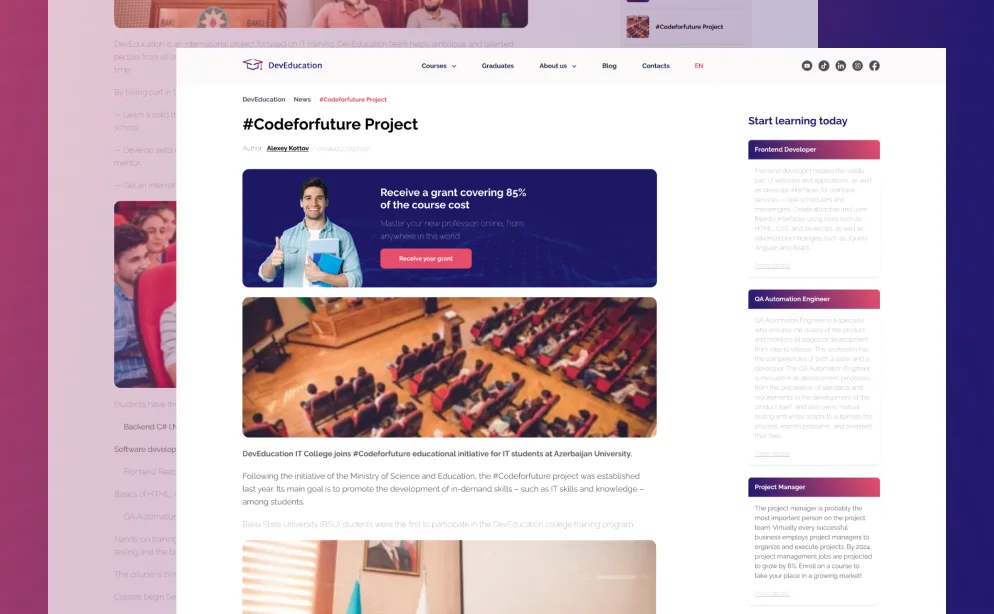Software Development
How to Setup Continuous Integration
In a CI model, your developers should be integrating code changes as soon as possible. But if a code change breaks your main branch and your developers keep adding more changes, it becomes difficult to identify what caused the initial failure. Successfully adopting CI starts with making sure your developers are integrating their code as soon as possible to a shared repository. Making builds readily available to stakeholders and testers can reduce the amount of rework necessary when rebuilding a feature that doesn’t meet requirements.
- The rest of the organization, marketing, sales, and product teams will also benefit from a CI pipeline.
- The
whole point of working with CI is that you’re always
developing on a known stable base. - As much as possible you
want to ensure that any later-stage failure leads to new tests in
the commit build that would have caught the bug, so the bug stays
fixed in the commit build. - It is a best practice to measure the CI pipeline speed and optimize as necessary.
Once code is integrated and tested, code on local machines is updated with frequent pulls so that developers are always working with the latest version of the code. You can make lots of code commits and have a fully automated build process. But just because a program runs, it doesn’t mean it’s running correctly. Each commit triggers a set of tests to identify bugs, security flaws, and commit issues. These tests are meant to keep the main code branch operational, or “green,” and give rapid feedback to developers about the efficacy of their code changes.
Integrated AppSec Solutions
Additionally, a CI tool does it automatically instead of having people manually run tests every time the code is integrated. It monitors the central repository and runs automated tests on every code change. Based on the results generated, the code is either accepted or rejected. GitLab CI is a development tool born out of the open source Rails project GitLab, which was produced by the company GitLab Inc. It offers intricate git storage organization with certain features such as code reviews, issue tracking, access control and many more. GitLab CI is completely incorporated with GitLab and it can effortlessly integrate into projects by utilizing the GitLab Application Program Interface.

Build scripts come in various flavors and are often
particular to a platform or community, but they don’t have to be. Although most of our Java projects use Ant, some have used Ruby (the
Ruby Rake system is a very nice build script tool). We got a lot of
value from automating an early Microsoft COM project with Ant.
DevOps Roadmap 2022: How to Become a DevOps Engineer in 8 Steps
A continuous integration pipeline automates stages of a project’s pipeline—such as builds, tests and deployments—in a repeatable way, with minimal human intervention. An automated continuous integration pipeline is essential to streamline the development, testing and deployment of your applications by enabling controls, checkpoints and speed. Continuous integration requires you to integrate work frequently, often many times per day. You verify integration by an automated build that detects integration errors as early as possible. Extending the rapid testing to run time tests in an automated testing environment leads naturally towards continuous delivery. In continuous deployment, the code changes to an application are released automatically into the production environment.

And the results from this build are examined the next morning and the full set of issues are then shared with the development team. Let’s start off by explaining what is CI and we will then enumerate the main benefits of continuous integration. Continuous integration (CI) and test-driven development (TDD), as part of architecture-based approach, extend basic agile practices enough to provide both high quality and project flexibility. The two developers must communicate with each other on which features work and how. This small team needs regular updates and must be able to integrate and test their code as a whole. Scheduling code check-in and testing take up a lot of development time.
Business Hours
Or, it can be partially automated with manual steps at critical points. What’s common in both scenarios is that developers always have a release artifact from the CI stage that has gone through a standardized test process and is ready to be deployed. It enables developers to evaluate more accurately and authorize precision more frequently. CI allows working groups to integrate code changes coming from multiple sources quickly.

To write good tests, you will need to make sure that developers are involved early in the definition of the user stories. This is an excellent way to get a better-shared understanding of the business requirements and facilitate the relationship with product managers. You can even start by writing the tests before implementing the code that will fulfill them.
The fundamentals of continuous integration in DevOps
The challenge is to secure CI without affecting the speedy delivery of software. DevSecOps build on the idea that “everyone is responsible for security” with the goal of safely distributing security decisions at speed and without sacrificing the safety required. Second luntbuild machine was used as a testing rig for integration testing. Continuous integration software continuous integration helps your team be more productive by freeing developers from manual tasks and encouraging behaviors that help reduce the number of errors and bugs released to customers. In the past, developers on a team might work in isolation for an extended period of time and only merge their changes to the master branch once their work was completed.
This is the foundation that enables your broader software delivery process to be efficient, resilient, fast, and secure. And by automating all integration steps, developers avoid repetitive work and human error. Instead of having people decide when and how to run tests, a CI tool monitors the central code repository and runs all automated tests on every commit. Based on the total result of tests, it either accepts or rejects the code commit. There is a greater likelihood of errors for software development teams that work in long feedback loops. Besides, the work needed to incorporate changes into a working software version also increases.
Refactoring is an opportunity to add tests
Over the past few years, Continuous Integration has become one of the best practices for software development. The goal is to detect the errors early on without having to wait https://www.globalcloudteam.com/ until the end of the project. One of the main benefits of integrating regularly and testing each integration is that you can detect errors more quickly and locate them easily.

It solves many of the early pitfalls that these nontraditional agile teams might have experienced without CI. Combining Continuous integration with test-driven development puts more people under the agile umbrella, because it allows agile methods to work more efficiently. For organizations that expect to grow, CI/CD can easily scale by team sizes, codebases, and infrastructure. CI/CD can reduce code integration workflows that are no longer needed, thereby also eliminating unnecessary team communications. A practical guide to the continuous integration/continuous delivery (CI/CD) pipeline..
The Four Activities of Continuous Integration
This ensures that new additions don’t break the functioning work that came before them, and developers whose code does in fact “break the build” can be notified quickly. In this stage, code is deployed to production environments, including public clouds and hybrid clouds. The deployment automatically launches and distributes software to end users. The automation tools move the tested and integrated software to places where it can be deployed to end users, such as an app store. Continuous delivery is the interim step of a software release pipeline that begins with continuous integration and ends with continuous deployment. The goal of these stages is to make small changes to code continuously, while building, testing, and delivering more often, quickly and efficiently.

